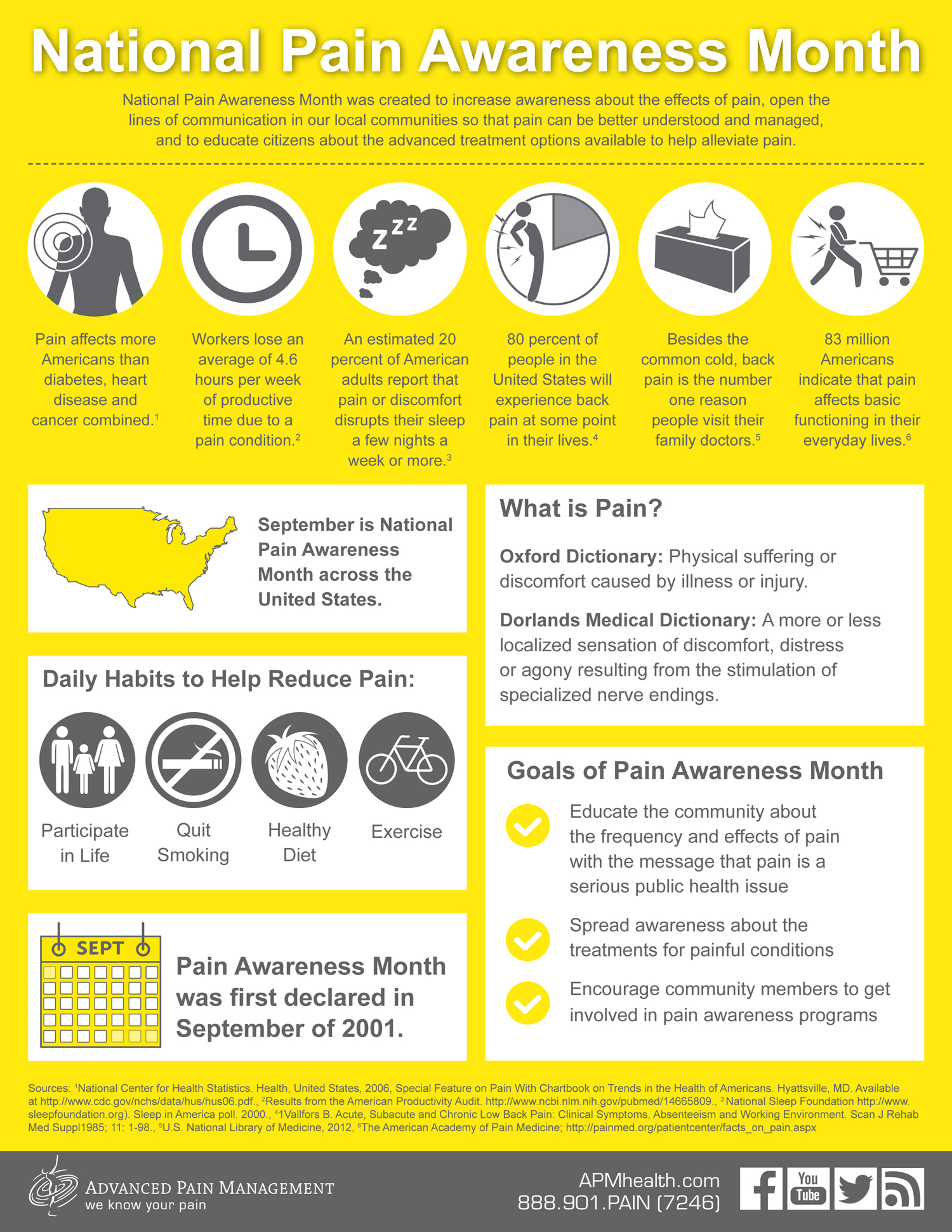The month of September has been declared Pain Awareness Month. This is a time when various organizations work to raise public awareness of issues in the area of pain and pain management.

Leg Pain & Numbness: What Might These Symptoms Mean?
Leg pain can range from a mild nuisance that comes and goes, to debilitating pain that makes it difficult to sleep, walk, or engage in simple everyday activates. The pain can take many different forms ‐ aching, searing, throbbing, or burning, and it can be accompanied by other symptoms, such as a pins‐and‐needles sensation, and/or leg or foot numbness or weakness.
Leg Pain Symptoms and Descriptions
Leg pain may be caused by a problem in the leg, but often starts with a problem in the lower back, where the sciatic nerve originates, and then travels along the path of the nerve (called sciatica). For this reason, diagnosis of anyone with leg/foot pain, and/or leg/ankle/foot weakness or numbness should include an exam of the lower back. Not all leg pain derived from low back problems presents the same way. Leg pain caused by a low back problem is often accompanied by additional symptoms, such as leg numbness or weakness, or foot pain, and the type of pain may vary widely from patient to patient. Typical descriptions of leg pain and accompanying symptoms include:
Burning pain. Some experience a searing pain that at times radiates from the low back or buttocks down the leg, while others complain of intermittent pain that shoots from the lower back down the leg and occasionally into the foot. Words used to describe this type of burning leg pain include radiating, electric or shooting pain that literally feels like a jolt. Unlike many forms of low back pain that can often be a dull ache, for many, leg pain can be excruciating and nearly intolerable. This type of burning pain is fairly typical when a nerve root in the lower spine is irritated, and it is often referred to as sciatica.
Leg numbness or tingling. Anyone who has had a leg or foot “fall asleep” and then gradually return to normal can imagine what numbness in a leg would feel like. Not being able to feel pressure, or hot or cold, is unnerving. Unlike the short-lived numbness of an asleep limb, numbness coming from a low back problem can be nearly continuous and can severely affect a person’s quality of life. For example, it can be difficult or almost impossible to walk or drive a car if one’s leg or foot is numb. Typical symptoms can range from a slight tingling sensation to complete numbness down the leg and into the foot.
Weakness (foot drop) or heaviness. Here, the predominant complaint is that leg weakness or heaviness interferes significantly with movement. People have described a feeling of having to drag their lower leg and foot or being unable to move their leg as quickly and easily as needed while walking or climbing stairs, for example, because of perceived weakness or slow reaction. Patients with foot drop are unable to walk on their heels, flex their ankle, or walk with the usual heel-toe pattern.
Constant pain. This type of pain is normally felt in the buttock area, so it is not technically leg Pain but it may accompany some form of pain felt in the legs. It may also be pain that occasionally radiates past the buttock into the leg. This type of pain is usually described as “nerve pain,” versus an aching or throbbing pain. It is typically present only on one side, and is commonly called sciatica or lumbar radiculopathy. It may often be relieved by stretching, walking or other gentle movement.

Positional leg pain. If leg pain dramatically worsens in intensity when sitting, standing or walking, this can indicate a problem with a specific part of the anatomy in the low back. Finding more comfortable positions is usually possible to alleviate the pain. For example, bending over may relieve pain from spinal stenosis, while twisting (as in a golf swing) can increase facet joint related groin, hip and leg ache. There are many spinal conditions that may cause leg pain, foot pain, and other lower extremity symptoms. Most successful treatments are based upon having an accurate anatomic diagnosis for the basis of a specific pain syndrome. Chiropractors are well suited to oversee the diagnosis and treatment of these situations.

Talk to Dr. O’Connell about specific questions related to your unique health situation.
Contact Dr. O’Connell to learn more or schedule an appointment
603‐641‐4800
